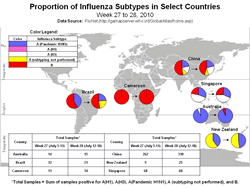Content on this page was developed during the 2009-2010 H1N1 pandemic and has not been updated.
- The H1N1 virus that caused that pandemic is now a regular human flu virus and continues to circulate seasonally worldwide.
- The English language content on this website is being archived for historic and reference purposes only.
- For current, updated information on seasonal flu, including information about H1N1, see the CDC Seasonal Flu website.
2009 H1N1 Flu: International Situation Update
August 3, 2010, 1:00 PM ET
This report provides an update to the international flu situation using data collected through July 25, 2010, and reported by the World Health Organization (WHO) on July 30.
Global Flu Activity Update
WHO continues to report laboratory-confirmed 2009 H1N1 flu deaths![]() on its Web page. These fatal cases are an under-representation of the actual numbers, as many deaths are never tested or recognized as flu related.
on its Web page. These fatal cases are an under-representation of the actual numbers, as many deaths are never tested or recognized as flu related.
Overall, flu activity due to 2009 H1N1 and seasonal flu viruses is low worldwide. However, some tropical regions, such as areas of the Americas and South and Southeast Asia, continue to report high levels of flu activity related to seasonal flu or 2009 H1N1. In the Northern Hemisphere, flu activity has been low or sporadic.
Southern Hemisphere
In the Southern Hemisphere, levels of flu activity vary by location. There is low, but increasing, flu activity in Australia and New Zealand. In Australia, 2009 H1N1 is the most common virus strain, followed by influenza A (H3N2) viruses. Virologic data from South Africa suggests flu activity has peaked, but remains elevated, mostly due to seasonal influenza B and A (H3N2) viruses. Overall, levels of influenza-like illness (ILI) in Chile remain low, except in the Los Lagos region. The majority of flu viruses in Chile and Argentina are 2009 H1N1 and seasonal B viruses. In tropical regions of the Americas, 2009 H1N1 and seasonal flu virus activity was reported in early July.
Asia
In Asia, India reported the most 2009 H1N1 activity. Low levels of 2009 H1N1 activity were also detected in several Southeast Asia countries, including Cambodia, Singapore and Malaysia. Singapore continues to report high levels of seasonal A (H3N2) activity.
Africa
In Sub-Saharan Africa, seasonal A (H3N2) and B viruses continue to circulate in parts of Kenya and central Africa (Cameroon), and pandemic flu transmission continues in Ghana.
Selected Highlights
- According to WHO, the majority of 2009 H1N1 virus isolates tested worldwide remains sensitive to oseltamivir, an antiviral medicine used to treat flu. Among 2009 H1N1 isolates tested worldwide, 302 have been found to be resistant to oseltamivir as of July 21st. Approximately 1% of U.S. 2009 H1N1 viruses tested by CDC since September 1, 2009, have been resistant to oseltamivir.
- Globally 50.7% of subtyped influenza A viruses were 2009 H1N1, according to WHO data collected from July 11-17, 2010, and reported on July 28.
- On February 18, 2010, WHO published recommendations for the following viruses to be used for influenza vaccines in the 2010-2011 influenza season of the Northern Hemisphere:
- an A/California/7/2009 (H1N1)-like virus;
- an A/Perth/16/2009 (H3N2)-like virus*;
- a B/Brisbane/60/2008-like virus.
* A/Wisconsin/15/2009 is an A/Perth/16/2009 (H3N2)-like virus and is a 2010 Southern Hemisphere vaccine virus.
Health Organizations
- World Health Organization (WHO)
- ECDC (European Centre for Disease Prevention and Control)
- H2P (Humanitarian Pandemic Preparedness)
- Public Health Agency of Canada
World Health Organization (WHO) Regional Offices
- AFRO (WHO Regional Office for Africa)
- AMRO (WHO Regional Office for the Americas) / PAHO (Pan American Health Organization)
- EMRO (WHO Regional Office for the Eastern Mediterranean)
- EURO (WHO Regional Office for Europe)
- SEARO (WHO Regional Office for South-East Asia)
- WPRO (WHO Regional Office for the Western Pacific)
Travel and 2009 H1N1 Flu
Human cases of 2009 H1N1 flu virus infection have been identified in the United States and several countries around the world. For information on 2009 H1N1 flu and travel, see the CDC H1N1 Flu and Travel website.
Reports and Publications
- White House Report on 2009 H1N1 in the Southern Hemisphere
Issued August 2009 – This White House report was prepared by the Department of Health and Human Services (HHS) in coordination with the Office of the Director for National Intelligence (ODNI) and the Department of State (Dos) and describes the characteristics and impact of 2009 H1N1 influenza A virus in the Southern Hemisphere. - ECDC Interim Risk Assessment Influenza A (H1N1) 2009 Pandemic
Issued July 30, 2009 - This document provides an interim risk assessment of novel H1N1 flu in Europe prepared by ECDC. - World Health Organization Weekly Epidemiological record – Issued July 24, 2009
This document by WHO provides updates on the international novel H1N1 flu situation. - MMWR – Update: Novel Influenza A (H1N1) Virus Infection – Mexico, March-May, 2009 – Issued June 5, 2009 / Vol. 58 / No. 21.
This Morbidity and Mortality Weekly Report describes the novel influenza A (H1N1) outbreak in Mexico from March-May, 2009. - MMWR – Update: Novel Influenza A (H1N1) Virus Infections – Worldwide, May 6, 2009 – Issued May 8, 2009 / Vol. 58 / No. 17.
This Morbidity and Mortality Weekly Report describes worldwide novel influenza A (H1N1) infections as of May 6, 2009.
Get email updates
To receive weekly email updates about this site, enter your email address:
Contact Us:
- Centers for Disease Control and Prevention
1600 Clifton Rd
Atlanta, GA 30333 - 800-CDC-INFO
(800-232-4636)
TTY: (888) 232-6348 - Contact CDC-INFO



